German Pinscher (original) (raw)
These intelligent, short-haired dogs nearly went extinct during World War II.
Origin and History
As their name suggests, German pinschers hail from southern Germany. The first German pinscher was registered in 1885. These intelligent, short-haired dogs nearly went extinct during World War II. In West Germany, there was no record of registration for one from just after the war until 1958. Luckily, they were brought back by an industrious breeder named Werner Jung. Jung smuggled a single female German pinscher out of the country and revived the breed with the blood of several miniature and regular pinschers. You can find German pinschers in a variety of colors, including red, salt and pepper, black, and various shades of tan or brown. Today, the breed is once again common across Germany. German pinschers can also be found in other parts of Europe, and they were brought to the United States just before 1980.
Now we know where the German part of their namesake comes from, what about “pinscher”? As these dogs and terriers were initially bred to be ratters, it is similar to “pincher”, which makes sense to them grabbing at rodents.
German pinschers are attentive and affectionate dogs who get along well with experienced owners. If you have time and energy for them, a German pinscher will be your best friend; these dogs love to spend time doing any activity their owner is interested in.
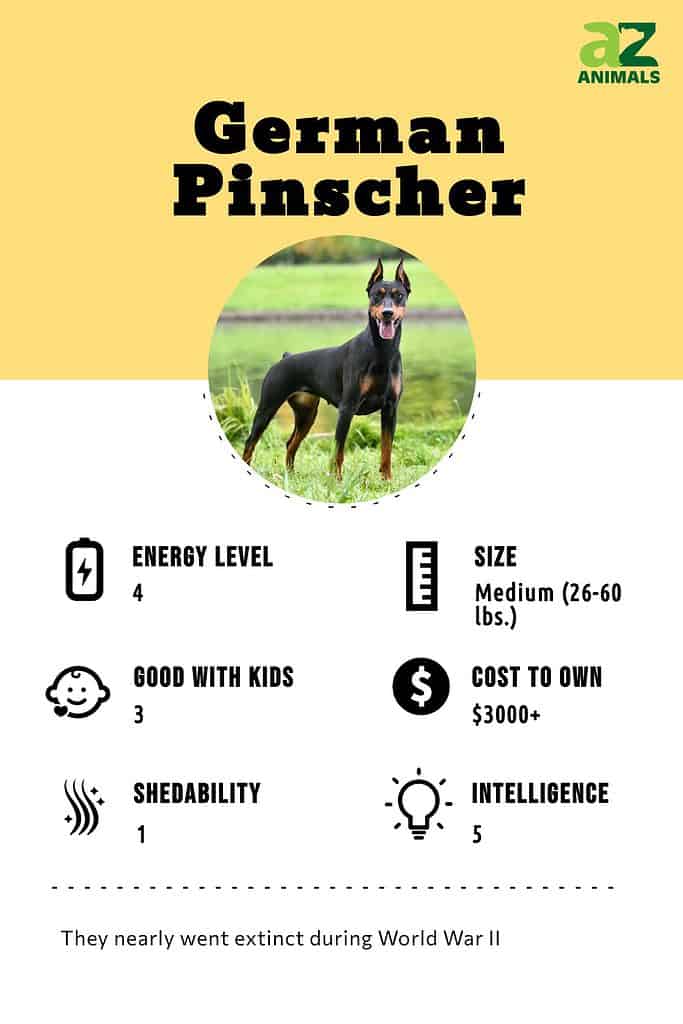
3 Pros and Cons of Ownership
| Pros! | Cons! |
|---|---|
| Eager and intelligent! German pinschers are smart dogs that listen for instructions and love to learn new commands. Your German pinscher may even communicate with you; just pay attention to their whines, barks, and eye movements. | Needs exercise. German pinschers are high-energy dogs, so they need at least two long walks a day. Only get a German pinscher if you have plenty of time for them. |
| Loves the family! German pinschers are incredibly attached to their families and owners. Expect this dog to take part in nearly every family activity. | Requires socialization. German pinschers have a strong guarding instinct. If you do not socialize your German pinscher as a puppy, they may have difficulty interacting with strangers. |
| Short-haired and shed-free! German pinschers have short hair, and their shedding is incredibly minimal. Brushing them with a cloth a few times a week should be enough to keep loose hairs off your furniture. | Not for new owners. German pinschers need clear and confident training from an early age. These dogs are best suited to experienced owners who can give them the time, attention, and skill that they need to thrive. |
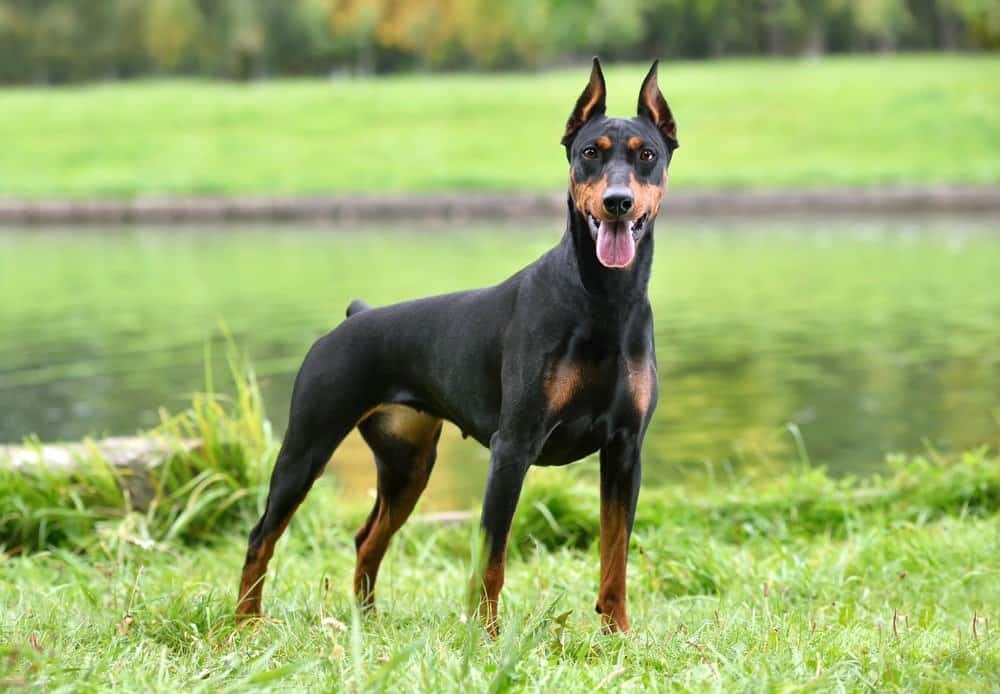
©eAlisa/Shutterstock.com
Size and Weight
German pinschers are medium dogs with short hair. Both males and females are about the same size. German pinschers can get as tall as 20 inches at the shoulder, and they typically weigh between 25-45 pounds when they are fully grown.
| Male | Female | |
|---|---|---|
| Height | 17-20 inches | 17-20 inches |
| Weight | 25-45 lbs | 25-45 lbs |
Common Health Issues
German pinschers nearly went extinct after World War II. The breed was actually revived in Germany from a single female and several normal and miniature pinschers. Because of the minimal gene pool, German pinschers should always be checked for health issues before adoption.
Responsible German pinscher breeders are able to avoid most genetic defects and produce healthy, long-lived dogs. However, some German pinschers may be susceptible to dysplasia of the hips and elbows. Another common health issue is the presence of cataracts, which can cause blindness if they are left untreated. Other problems like thyroid disease and Von Willebrand’s disease pose long-term health problems in older dogs. Finally, German pinschers are also at risk for heart disease; luckily, this can often be noticed early and treated by your vet.
In summary, the most common health issues for German pinschers include:
- Joint dysplasia
- Cataracts
- Cardiac disease
- Thyroid disease
- Von Willebrand’s disease
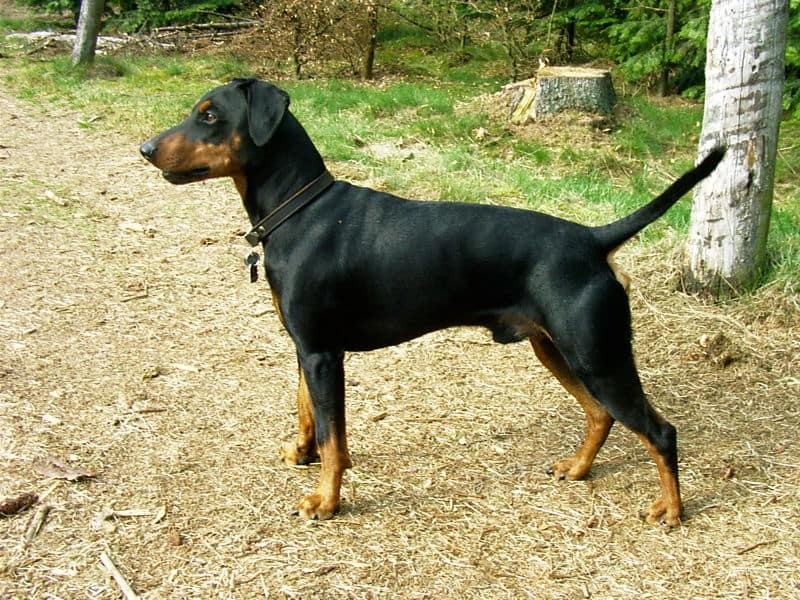
Some German pinschers may be susceptible to dysplasia of the hips and elbows.
©Stesi / Creative Commons – Original
Temperament
These are intelligent, energetic, protective, and loving dogs. German pinschers take incredibly well to training, but they also have a strong independent streak; if you do not establish dominance early in the relationship, your German pinscher may try to take control for themselves. Because of this, German pinscher puppies should only be adopted by owners who are ready to commit to their training for the first few years of their lives.
Aside from the need for an attentive owner, German pinschers have many wonderful traits and are excellent pets. A German pinscher is a fine choice for a family with older children, but they may be too jumpy to live with very young children. Owners should be aware that German pinschers are guard dogs; they have very protective personalities and may not get along with strangers or other dogs unless they are properly socialized.
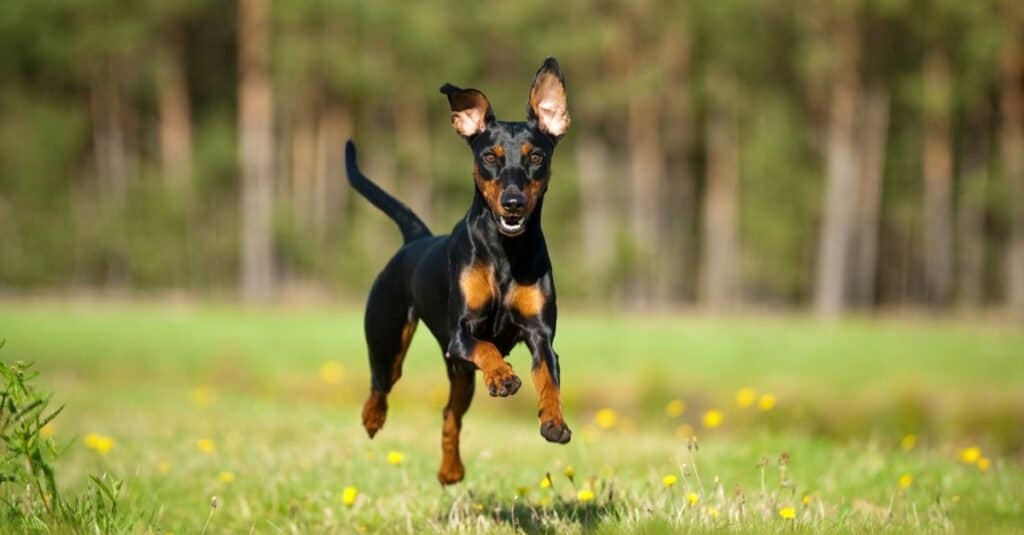
The German Pinscher is an excellent watchdog because of its alert and watchful nature.
©Dora Zett/Shutterstock.com
How to Take Care of Them
German pinschers are moderately difficult to take care of compared to other dogs. They need attentive training and a high level of exercise in order to stay happy and healthy. Luckily, German pinscher puppies are incredibly intelligent and will pick up most commands after only a handful of repetitions. Once your German pinscher is trained, you will find that they are an accommodating and engaging pet.
The Best Dog Food
German pinschers are extremely active dogs, which means that they may need to be fed more than other breeds of the same size. A German pinscher puppy may need as many as four meals a day, although this amount should be decreased to three and then two times a day as the puppy ages.
Adult German pinschers still need enough calories to maintain their active lifestyle, but two light meals a day is usually enough to help them stay fit and happy. Look for dog food that has plenty of protein, fiber, and healthy fats. You may also want to consider feeding your German pinscher a calcium supplement to combat their risk of joint dysplasia; just make sure to consult with your vet before adding any vitamin or mineral to your dog’s diet.
You may also want to discuss this breed’s risk of cardiac disease at vet appointments. Look into the link between dog food containing legumes, and heart failure in dogs, and aim for legume-free dog food.
By our estimation at A-Z Animals, the best dog food for German Pinschers is Farmina Natural & Delicious Ocean Ancestral Grain Cod & Orange Adult Medium & Maxi Dog Food.
You won’t find any worrying legumes like peas and lentils, here. Rather, the ingredients include real cod fish and nutritious grains. The glucosamine in this food helps protect against joint dysplasia. There are carrots, which are excellent for eye health, and taurine aids eye health, too, while also nourishing a healthy heart.
See how your dog feels eating Farmina N&D Ocean Ancestral Grain Cod dog food, available on amazon.
[lasso id=”425090″ link_id=”1751374″ ref=”farmina-nd-ocean-codfish-orange-ancestral-grain-medium-maxi-adult-dry-dog-food”]
Maintenance and Grooming
German pinschers are a short-haired breed with incredibly minimal shedding. In fact, your German pinscher probably won’t need to go to the groomer except to get their nails trimmed.
Still, German pinschers do need a moderate amount of brushing to keep their coats glossy and smooth. Don’t use a long-bristled brush, as it may be too rough for your pinscher’s sensitive skin. instead, look for a cloth or a grooming mitt that will gently gather excess hairs.
Training
If you have the attention and dedication, German pinschers are incredibly easy to train. These dogs love to learn new commands and hate when they have to go through the same lesson twice. A German Pinscher needs an authoritative trainer who can understand the dog’s body language. These dogs are not recommended as pets for new dog owners.
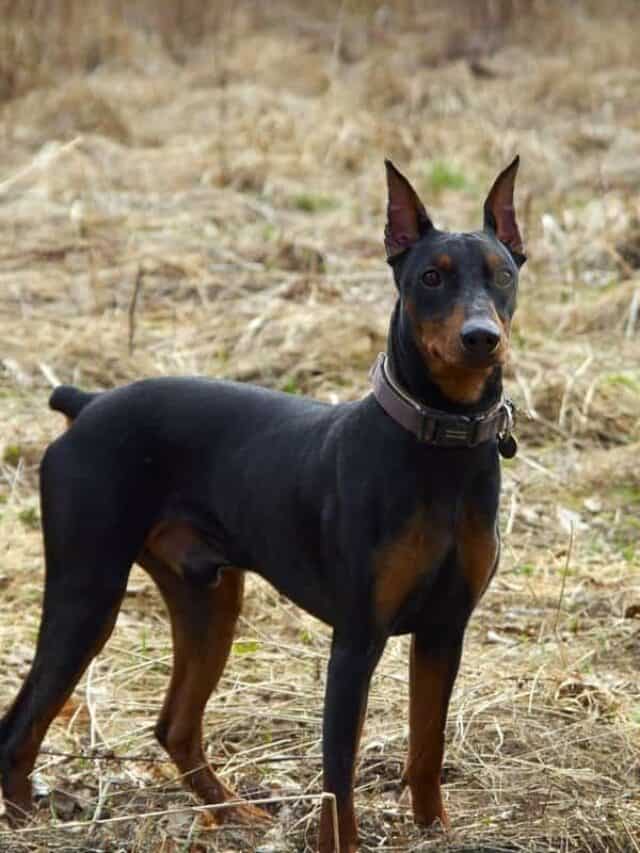
These dogs love to learn new commands and hate when they have to go through the same lesson twice.
Exercise
The German Pinscher needs a moderate to a high amount of exercise. Most breeders recommend taking your German pinscher on at least two long walks a day. Although they prefer having access to a backyard, German pinschers are relatively calm dogs and can live in an apartment if they are taken out three to four times a day.
When it comes to activities, your German pinscher will be excited to participate in anything you can come up with. From fetch to mock hunting, there are few canine sports that a German pinscher won’t want to participate in. However, German pinschers are not actually hunting or sporting dogs, so make sure to keep their activities at a casual level.
Puppies
German Pinscher puppies are incredibly attached to their owners. Be ready to spend time developing a bond with your dog and socializing with them as early as possible. Because German pinschers are naturally protective, they may be aggressive to strangers if they are not actively socialized during the developmental years of their life.
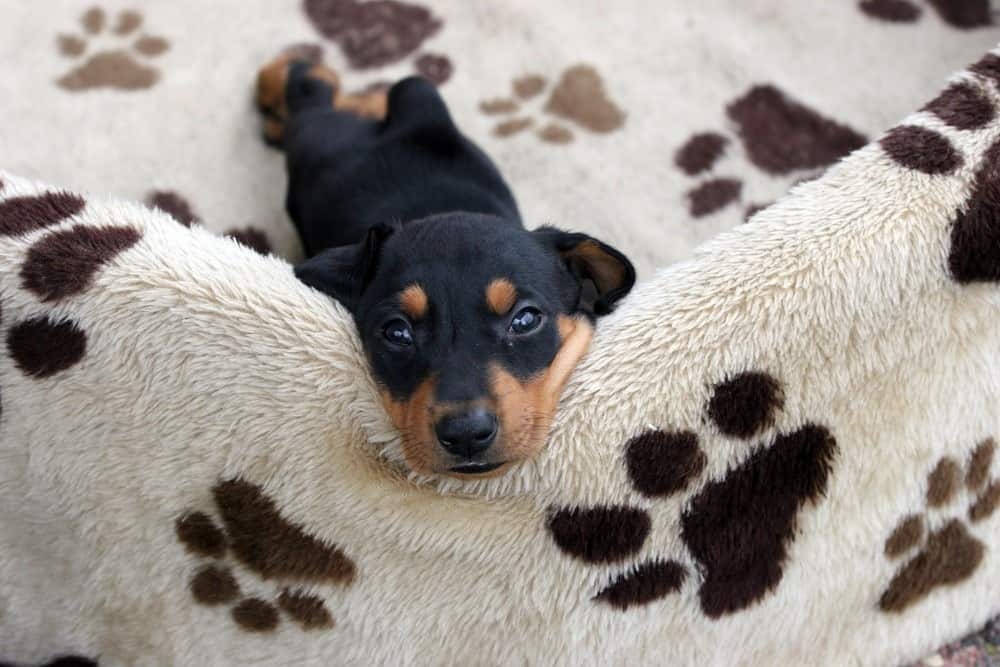
©Pictries/Shutterstock.com
With Children
German pinschers are sweet and loving dogs that get along incredibly well with their owners. This breed is well-suited to being a guard dog; most German pinschers are very protective of everyone in their family. German pinschers are good with kids, but they may be annoyed or irritated with very young children. A German Pinscher should always be trained by an experienced adult who is ready to take responsibility for their behavior.
Similar Dogs
German pinschers are a rare breed, and they might not always be available in some areas. If you’re looking for a similar dog, consider adopting a Doberman pinscher, affenpinscher, or German shepherd.
- Doberman pinschers – Doberman pinschers are only distantly related to German pinschers, but they share a similar appearance and attentive personality. Doberman pinschers are working dogs and may require more attention than German pinschers.
- Affenpinschers – The Affenpinscher is a fluffy, attentive toy dog that is also a member of the pinscher family. Although they require more grooming, Affenpinschers are friendly, fun, and receptive to training.
- German shepherds – They might be large, but German shepherds are sweet and loving dogs that do well in active families. These dogs respond quickly to commands and love to participate in activities with their owners.
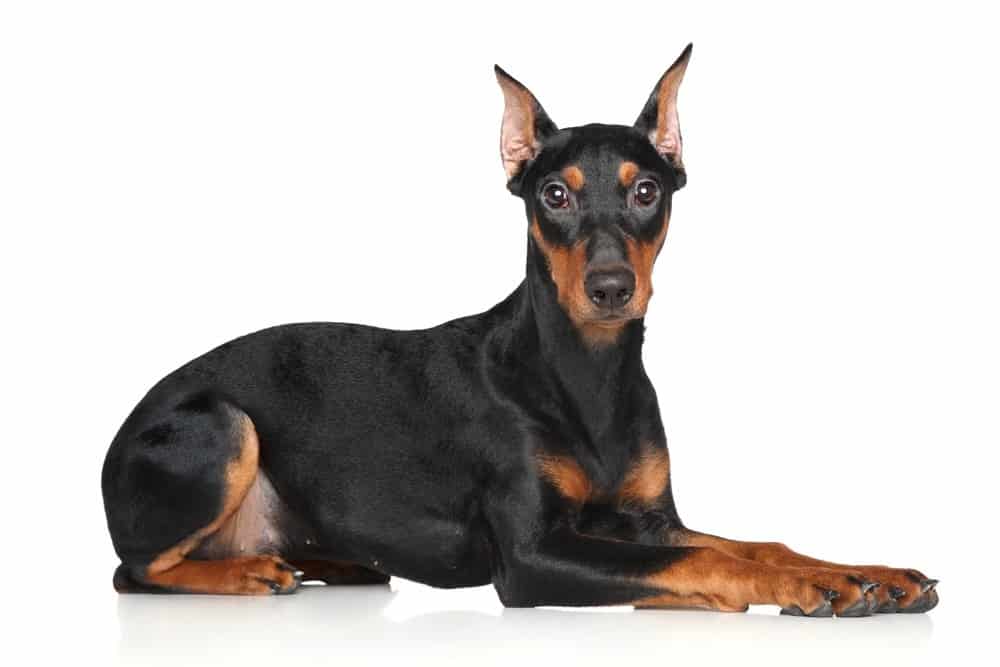
Because German pinschers are so rare, you may want to consider adopting a similar breed, like a Doberman pinscher, affenpinscher, or German shepherd.
©Jagodka/Shutterstock.com
German Pinscher vs. Doberman Pinscher
German pinschers and Doberman pinschers look similar, so it’s no surprise that most people confuse these two breeds. In fact, German pinschers are actually one of the contributing breeds to the Doberman bloodline. Because Doberman pinschers have many contributing bloodlines, they are less susceptible to health issues. They are also typically larger and have more work-oriented personalities. Neither of these breeds should be confused with the miniature pinscher, which has a similar but far smaller build.
Popular Names
Popular names for German pinschers include:
- Bandit
- Ragnor
- Roxy
- Elsa
- Precious
- Sammy
- Pepper
- Caesar
View all 220 animals that start with G
A purebred German pinscher will cost anywhere from 2,000to2,000 to 2,000to6,000. Good breeders will charge more to ensure that your German pinscher has an even temperament and is free from any health problems. Luckily, German pinschers are relatively low-maintenance and do not typically cost more to own than any other dog.
German pinschers are good with older children, especially if they have been properly socialized as puppies. These dogs are not a good choice to have around very small children.
German pinschers have a strong guarding instinct and may show aggressive behavior if they are not properly trained. However, most German pinschers are also incredibly obedient and get along well with both people and other pets.
A fully-grown German pinscher can weigh anywhere from 25 to 45 pounds.
German pinschers are wonderful and intelligent pets, but they are best suited for experienced owners. German pinschers need plenty of training, exercise, and attention to stay happy.
German pinschers get along quite well with dogs that are their own size or bigger. Because they were originally bred to chase rodents, German pinschers may chase smaller pets, especially if they run.
Most German pinschers live to be around 14 years old. Past this age, vision loss, joint dysplasia, and heart problems become more serious concerns.
German Pinschers are Omnivores, meaning they eat both plants and other animals.
German Pinschers belong to the Kingdom Animalia.
German Pinschers belong to the class Mammalia.
German Pinschers belong to the phylum Chordata.
German Pinschers belong to the family Canidae.
German Pinschers belong to the order Carnivora.
German Pinschers are covered in Hair.
German Pinschers belong to the genus Canis.
The scientific name for the German Pinscher is Canis lupus.